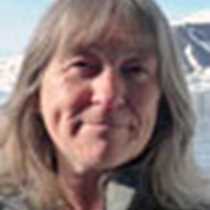St Kilda
Westwards we sailed into the Atlantic overnight on a milk-calm surface until early morning, when the looming shapes of the Kilda archipelago began to take form on the horizon. St Kilda is one of the most remote and inaccessible parts of the British Isles, lying 160km off the west coast of mainland Scotland. Hirta is the main island in this isolated volcanic archipelago and was the focus of human settlement for at least four thousand years. The smaller islands and stacks in the group provide nesting sites for thousands of seabirds—northern gannets, fulmars, puffins, kittiwakes, guillemots, razorbills—which also formed an essential part of the St Kildan economy.
In sheltered Village Bay, we were welcomed by the National Trust for Scotland’s warden Paul Sharman, before going ashore to explore the island and its natural and cultural history. The present village was laid out in the 1830s, with 26 blackhouses (thick-walled stone and earth-built houses shared by people and cattle), each on an individual strip of cultivated land. These were superseded 30 years later by the erection of 16 new stone cottages built from imported materials. The population declined in numbers during the later 19th and early 20th centuries, until 1930 when the remaining 36 inhabitants finally agreed to be re-located to the mainland. They left together on 29 August, leaving their family bibles in their houses open at Exodus.
Some of us climbed up to ‘The Gap,’ to gaze 400ft down the vertical cliffs to the crashing Atlantic waves below and the relict landscape behind—fields, enclosures, and other structures surviving from earlier times. Strewn amongst them were examples of stone tools of prehistoric date quarried from the slopes of Ruibhal, or made from beach stones.
Meantime the St Kilda wrens, a separate sub-species, filled the air with song. Fulmars gazed on us from the roofs of cleits, the ubiquitous drystone, turf-capped storage huts used for everything from peat fuel to dried seabirds. Everywhere were the Soay sheep with their new lambs, the oldest, most primitive sheep in Britain, probably first brought to St Kilda 4,000 years ago. Now completely wild, they roam the island unhindered, and provide doctoral theses for many young biologists.
After a Zodiac cruise among teeming life around the cliffs and caves of Dun, the National Geographic Explorer turned eastwards to Bororay and its outliers of Stac an Armin and Stac Lee. The water was bright with rafting puffins, and the air thronged with gannets of streamlined shape and golden heads. We looked up in awe at the crowded ledges, wondering how the St Kilda men could climb those vertical faces to collect their avian harvest.
Just as we thought a wonderful day was coming to an end, a pod of Killer Whales appeared, three males up to 30 feet long and females with a calf, allowing us fantastic views at close quarters. St Kilda truly lived up to it dual World Heritage status, its rich island and marine life, and its human story, each element inextricably linked.




